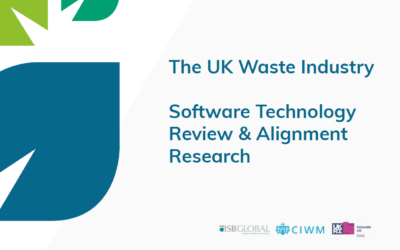Benefits of automated reporting in waste management – and how to make it happen
Reporting is a method of collecting data to present useful, focused and trustworthy information, gathered from a business process. This data can be used to ensure that well informed decision making takes place. In the waste management industry, having access to accurate and up-to-date information is essential to ensuring operational efficiency. And if you can use your waste management software to automate time consuming and repetitive processes, the benefits can be even greater.
In this blog post, we explore the advantages of deploying automatic reporting in your waste management system, and how to actually make it happen.
The Business Uses of Reporting in waste management
Reports can be used to improve business performance, and are typically used in the following ways:
Data Collection & Report Building: A report is produced, containing business data that has been processed and organised to relay specific information or recount certain events in a widely presentable and scrutinised form. A report can provide context and inform specific decisions.
Analysis of the Reports: The report is analysed, with a particular focus on the question or process the company is trying to understand. A report helps highlight where your efforts should be put, where you aren’t achieving the results you expected (areas underperforming), and points towards next steps needed to change or achieve this.
Intelligence: From the data, conclusions are drawn, which provide insight into a particular part of the business. This allows companies to see what is really going on, and make informed decisions about future plans, or make changes and improvements to their processes and operations.
This is just one example of how reporting can help your waste management business to operate more efficiently, become more profitable and grow. But getting to this point means investing time and resources into reporting, analysis and optimisation activities. Which means you want to make sure this activity is providing value and is not reporting for reporting’s sake.
The problems with manual reporting
Bias / inaccuracy – Many manual reports require further worker intervention in order to present the data in an accessible format. This can mean that the data has been condensed or already interpreted by the complier to a certain extent. It may also contain inaccuracies where data has been copied to a different format, for example copied into a spreadsheet. Consider also what happens when the ownership of reporting or data collection changes when someone leaves or is absent – if there is not a clear process and quality assurance in place, this can lead to further inaccuracies and misinterpretations.
Trust of data – When relying on multiple systems for your reporting, each may produce data that conflicts with that from other systems. It can be difficult to integrate and reconcile data across different processes to ensure you have the range of information you need. Combine this with potential inaccuracies of manual reporting mentioned above, and you could find yourself spending more time checking that data is accurate than you do analysing the results and developing insights.
Resources – It takes time and resources to set up or pull off reports manually. It is harder to tailor reports to what you need to know without much time and effort. The compiler needs to understand what it is you need information on and so you may need a specialist to produce reports.
Speed – Information is a snap-shot of the state of things at the time the report was pulled off. It does not reflect data in real time. And when expanded to cover the different datasets and systems they live within, you run the risk of comparing oranges with apples.
Regularity – To get the most out of data, it is useful to build up a set of reports that are comparable – taken at the same time interval. This allows for benchmarking to occur. In a manual process, if a report is not run on time you might have gaps in your data (for example If someone is off sick or forgets to run the report).
So it is clear for these very reasons, that an automated waste management reporting, is the ideal answer to ensure that the data is collected, processed and made ready for you to analyse on time, every time. Here are the specific areas such a system could positively impact.
Benefits of Automated Reporting in waste management
Real Time Business Intelligence
Real-time business intelligence is a concept describing the process of delivering business intelligence (BI) or information about business operations as they occur. The speed of today’s processing systems has allowed typical data warehousing to work in real-time. Real time means near to zero latency and access to information whenever it is required. The result is real-time business intelligence that helps the user to react to events as they occur.
In this context, “real-time” means a range from milliseconds to a few seconds (5s) after the business event has occurred. While traditional BI presents historical data for manual analysis, BI compares current business events with historical patterns to detect problems or opportunities automatically. This automated analysis capability enables corrective actions to be initiated and/or business rules to be adjusted to optimise business processes.
Real-time alerts
Reports can be customised or alerts set up to provide the data you need. This allows staff to carry on with their day to day activities, and be notified when things happen that they need to know, such as when an anomaly occurs.
At-a-Glance Dashboards
Dashboards often provide at-a-glance views of KPIs (key performance indicators) relevant to a particular objective or business process (e.g. sales, marketing, human resources, or production).
Often, the “dashboard” is displayed on a web page that is linked to a database, which allows the report to be constantly updated. For example, a manufacturing dashboard may show numbers related to productivity, such as number of parts manufactured, or number of failed quality inspections per hour. A human resources dashboard may show numbers related to staff recruitment, retention and composition, for example number of open positions.
Digital dashboards allow managers to monitor the contribution of the various departments in their organisation. To gauge exactly how well an organisation is performing overall, dashboards allow you to capture and report specific data points from each department, thus providing a “snapshot” of performance.
Benefits of using digital dashboards include:
- Visual presentation of performance measures
- Ability to identify and correct negative trends
- Measure efficiencies/inefficiencies
- Ability to generate detailed reports showing new trends
- Ability to make more informed decisions based on collected business intelligence
- Align strategies and organizational goals
- Saves time compared to running multiple reports
- Gain total visibility of all systems instantly
- Quick identification of data outliers and correlations.
Customisation
What’s more, the dashboards you create can be customised and tailored for the needs of the different teams within your business. Reports, KPIs and metrics will have different levels of importance, depending on the job role of the person reviewing them. So, once you have your data, reports and dashboards setup, it’s worth investing time into understanding how this information can benefit all areas of your business.
Spend time with the different stakeholders within your teams, and find out what information would be most useful and insightful to them. Then build them their own dashboard so they have real-time access to this important information. The advantage of automated waste management system reporting is that you can present the same data in various ways to gain different insights, without needing to increase the time required to collect and update the reports themselves. And you’ll soon be hearing from them on additional ways to improve your business operations that you might not have even considered before!
How Waste & Recycling One can be used to inform your business
ISB Global’s software solution, Waste & Recycling One has a suite of pre-built reports covering the full end-to-end waste and recycling process. Data can be displayed in forms or output using SAP Business Objects Crystal Reports, which is embedded in the software. Other scalable analytics and intelligence packages are also available.
To help you get started with the most common reports, you can choose off-the-shelf versions of the customer and supplier web portal. Then you can go a step further and design your own reports, analytics and intelligence platforms using SmartWorld: our mobile, web and IoT connectivity innovations platform. You can design your own mobile alerts with information you want to receive to any operating system and any device in real time.
All of this enables your team to get to the data and insights that are most relevant for them, enabling them to drive positive change within your business sooner.
Waste & Recycling One, User Cockpit & Dashboards
Waste & Recycling One User Area or “Cockpit” allows you to control the entire end-to-end process from one screen. You can monitor data as it moves through the process, from quote, job order, operations, logistics, customer service, accounting and banking.
You can ensure that you are alerted automatically to anomalies in the process by adding rules to the master data throughout the entire end to end process. This can save time, while delivering critical operations and financial data straight to your laptop or mobile device.
Reporting & Business Intelligence for Any Data, Anytime & Anywhere
As Waste & Recycling One is one software solution, data throughout the end to end process can be displayed in dashboards accessible via workstations or mobile devices. This means that whatever the users role, they can be alerted to action through various settings on data while they go about day to day operations.
For example, a worker enters their messages and sees alerts ready to authorise. They can authorise or decline this immediately, send a message and log the auditable action in the software.
Similarly, a weighbridge transaction is incorrect. The revised weight sends the profitability gauge to red. Immediate investigations can be made to uncover the problem and rectify the situation, rather than wait until finance highlight the issue several days later when it is too late.
Graphs, Gauges & Dials for Business Critical Data
The Waste & Recycling One User Area allows the worker to monitor all their areas of responsibility, accounts, operations, logistics and customer service. Messages, alerts and tasks filter through ready to take actions on, while graphs, gauges and dials show key performance indicators and critical business information in real time.
You can configure the User “Cockpit” to include:
- Gauges to show when profitability within a certain time frame goes into the red
- Graphs to show material flows and levels of profitability
- Charts to show daily cash flow against operations.
These are just some of the many examples that automated waste management system reporting can uncover huge benefits in your business’ operational efficiency and profitability. If you’d like to learn more, speak to one of our team today.
Find out more about the Waste and Recycling One software solution
Read more about Whole Business reporting and BI






